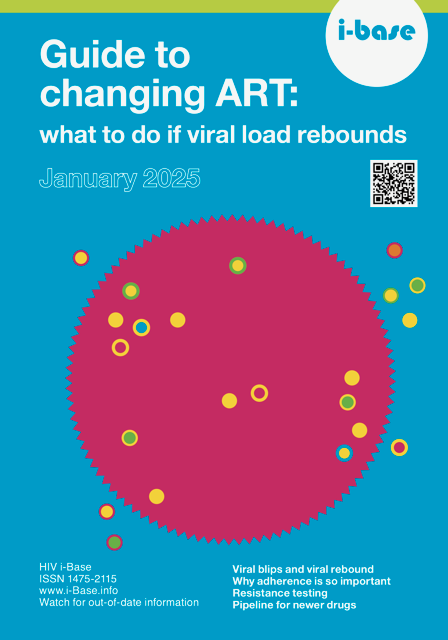Glossary
 amino acid – a group of three bases (or base pairs) that are the building blocks for proteins and peptides. There are 26 naturally occuring amino acids.
amino acid – a group of three bases (or base pairs) that are the building blocks for proteins and peptides. There are 26 naturally occuring amino acids.
ART – antiretroviral treatment (see also HAART or cART).
ARV – antiretroviral – any HIV drug.
base – (also called nucleotide) – the building blocks in DNA that form amino acids. There are four bases represented by the letters A (adenine), T (thymine), C (cytosine) and G (guanine). In RNA the thymine is replaced by U (uricil).
cART – combination ART – an earlier term for ART.
CCR5 inhibitor – type of HIV drug (an entry inhibitor) that blocks HIV from getting into a CD4 cell. CCR5 is a co-receptor on the surface of a CD4 cell that HIV uses to attach itself to the cell. CCR5 inhibitors block that process. Maraviroc is currently the only approved CCR5 inhibitor.
confirmatory test – a second test to double-check the results of a previous one. For example, if your viral load is usually undetectable and then becomes detectable, you need a second confirmatory test. This is to check that the detectable result was not a laboratory error on just a temporary blip.
cross-resistance – where resistance to one drug means HIV is also resistant to similar drugs.
expanded access programme (EAP) – a scheme that allows people to access a drug before it has been approved (but when approval is expected). EAPs are for people urgently need treatment as a life-saving option and who do o have the time to wait for the six months that it takes for approval to be finalised. EAPs are usually available for most HIV drugs after the main studies (phase 3) have been completed. They were an important early result of community activism. They are also called ‘early access’ or ‘named-patient’ programmes.
fold-change – a term relating to drug resistance after a phenotype test. 4-fold resistance (also called a 4-fold loss in sensitivity) means you need to use four times the dose to get the same reduction in viral load.
fusion inhibitor – a type of HIV drug (an entry inhibitor). Fusion inhibitors stops HIV ‘fusing’ to a CD4 cell. T-20 (enfuvirtide, Fuzeon) is only currently licensed fusion inhibitor.
genome – term for the genetic material (RNA or DNA) of any organism.
genotype – relating to the genetic structure of an organism.
HAART – a early term for combination therapy (Highly Active AntiRetroviral Therapy), usually 3 or 4 ARVs. This is now rarely used.
integrase inhibitor – a type of HIV drug that stops HIV genetic material from ‘integrating’ into the DNA in a cell. This is a newest family of HIV drugs. It includes raltegravir, elvitegravir and dolutegravir.
log – a number expressed as a factor of 10 – ie 2 logs = 10 x 10=100; 3 logs = 10 x 10 x 10=1000. This measurement is used when needing to include very large and very small numbers on the same scale. A reduction by one log is a 90% reduction. A reduction by two logs is a 99% reduction etc.
mutation – a change in the structure of the virus that can stop a drug from working.
NNRTI – Non-Nucleoside Reverse Transcriptase Inhibitor, a type of HIV drug (eg nevirapine, efavirenz and etravirine).
NRTI or ‘nuke’ – Nucleoside Reverse Transcriptase Inhibitors (also called nucleoside analogues) are a family of drugs that includes AZT, d4T, 3TC, FTC, ddI and abacavir. Tenofovir is a nucleotide RTI and works in a similar way.
phenotype – relating to how an organism behaves, based on how its genotype relates to its environment.
PI – Protease Inhibitors are a family of drugs that includes indinavir, nelfinavir, ritonavir, saquinavir, fosamprenavir, atazanavir, lopinavir, tipranavir and darunavir.
salvage therapy – an old term for the combination therapy used after someone has developed resistance to three or more classes of HIV drugs. Also called ‘third-line’ or ‘rescue therapy’ or ‘treatment of patients with multidrug resistance’. Now rarely used.
second-line therapy – the combination used after your first treatment has failed.
treatment-experienced – someone who has previously used HIV treatments.
treatment-naive – someone who has never taken any HIV treatments before. [note: people who are treatment naive can still be resistant to HIV drugs if they were infected with a drug resistant strain of HIV]
viral tropism – the type of coreceptor used by HIV in order to attach to and then infect a cell. If HIV uses the CCR5 coreceptor on the surface of the a CD4 cell it is called R5-tropic. If it uses the CXCR4 co receptor it is called R4-tropic). Early HIV infection is usually R5-tropic but over time, especially in late disease (if CD4 counts drop to less than 50 cells/mm3) the virus shifts to being X4-tropic. Mixed tropic refers to a having some viruses that use R5 and some that use X4.
viral load test – a blood test to measure the amount of HIV in your blood. Each test has a cut-off (ie 50 copies/mL). Results below this cut-off are called ‘undetectable’.
viral rebound – when your viral load has been undetectable (under 50 copies/mL) and then becomes detectable. Sometimes viral rebound can be a lab error, sometimes a small temporary blip, and sometimes a real rebound that shows your virus may have developed resistance to one or more of the drugs in a combination treatment. See: virological failure.
wild-type virus – HIV that has no drug resistance mutations. This is usually the virus that you are first infected with.
Last updated: 1 January 2025.
